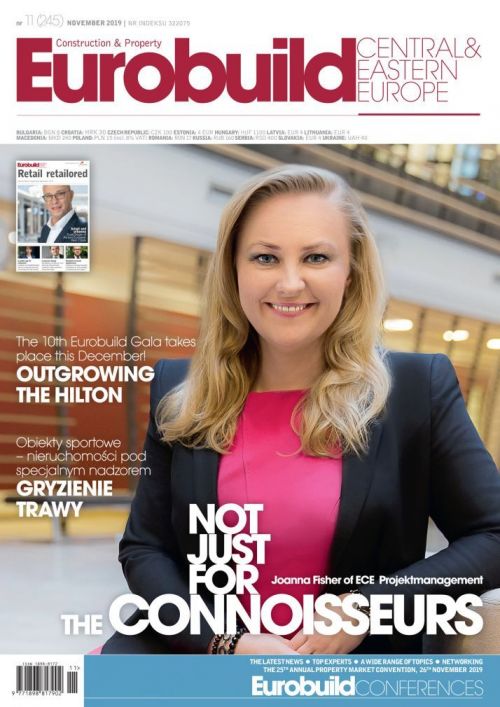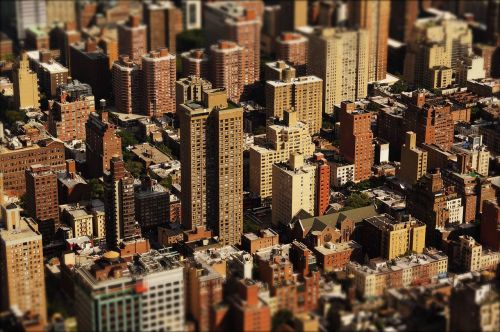The inside experience
Interior design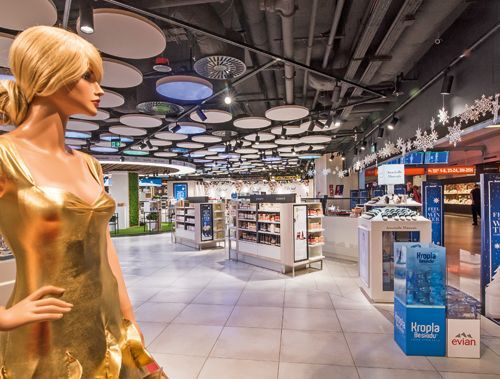
For some time now retail might have been moving online, but traditional stores are not willing to give up the ghost so easily. Shop interiors have become their marketing weapons in this battle. Unsurprisingly, retailers are increasingly opting for original layouts. Another factor driving this is the digitisation of offline shopping, which has been transforming consumers’ shopping habits. The actual functions of stores today have been changing, sometimes transforming into showrooms. You can see and try out the different products in them; and the way the stores are designed has become an inseparable element of the brand’s image. As this trend takes hold, shops are gradually becoming brand embassies, and the customers are taking on the role of ambassadors. This poses a real challenge for designers – they now have to utilise knowledge from various fields and embrace the interdisciplinary nature of their task. And the most important goal for them now is to design interiors that it is difficult to be indifferent to.
Omnipresent digital
It’s not only the design, light and sound that are important, but also the smell of a place. Retailers are increasingly focusing on interactivity, and so modern stores are turning into places packed with tech designed to stimulate all the senses. “The internet and mobile channels now seem to offer an infinite number of products that tempt the consumer with lower prices, greater convenience and faster despatch. Contrary to appearances, this does not spell the end of the brick-and-mortar store. Retail has actually been evolving under the influence of new technology,” claims Mateusz Laskowski, a board member of Forbis Group. According to Grzegorz Rogacki, the head of the design team at ARS Retail, new systems are changing retail interiors in both visual and functional ways. According to him, the modern shop has become a marketing tool and no longer a store for products. What does this amount to in practice? “Interactive mirrors can be used to show how the chosen item of clothing looks on us and to suggest matching clothes – so this involves a digital cross-over and up-selling in real time. Cosmetic brands can use such digital mirrors to help to choose make-up and hair dye colours. While in the clothing store, you can also scan the QR code on a mannequin wearing a matching outfit, and all the clothing items, in their correct sizes, will then be delivered to the fitting room. VR headsets can be used to walk around a virtual apartment fully furnished with interior design products. It’s even possible to complete an order during such a ’stroll’. AV applications allow you to see what furniture will look like in your apartment. Virtual reality is also used to present what is on offer in an attractive way. Such possibilities are now being tested in one of the BNP Paribas Polska bank’s Warsaw branches, which we designed” reveals Grzegorz Rogacki.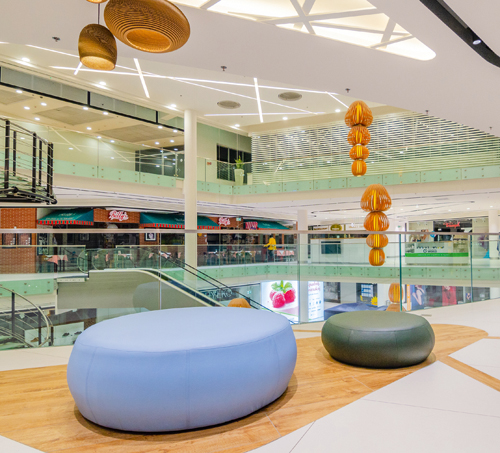
Designs by Tétris (Galeria Madison mall in Gdańsk)
Mobility is the key
Personalisation is another good way to reach customers. In store interiors, this generally means having a layout that fosters less formal relationships that enhance the shopping experience. Transaction mobility is also one of the key trends shaping the retail of the future. “Mobile shopping can be done anywhere – on the bus, sitting in a restaurant, while on a stroll through a mall or even in a brick–and-mortar store. Transferring the transaction process online will make cash registers in stores unnecessary or their actual use negligible. But we shouldn’t worry about this making shop staff obsolete. On the contrary – staff in stores packed with technology will have a new, more important role. The consumer needs reliable information and often some help in choosing a product or advice – store employees will be brand ambassadors instead of being operators of checkout terminals. The transaction will be carried out by the customers,” explains Grzegorz Rogacki.
The designers agree that modern retail space must come with a good degree of added value. The shops of the future will ‘sell’ an experience. This follows the trend for consumers to see stores as places where they can acquire new skills or form relationships with people with similar interests. “One example is Canadian brand Lululemoon, which has grown from a producer of yoga gear to a company competing with the leading sportswear producers. This started by opening an area in the store for practising yoga. This encouraged a community of people to form with similar interests. Healthy lifestyle training sessions, cookery classes and make-up demonstrations will continue to be popular in shops. Even the store designed by our company for online cosmetics brand Nutridome in Galeria Słoneczna in Radom is used as a place for learning how to apply the products,” comments Grzegorz Rogacki. According to him, this trend will result in the blurring of the boundaries between the functions of retail space. “We are applying this principle in introducing L’Oréal Emotion to hairdressing salons, which involves opening a consultancy and resale point for the brand’s products in the store,” says Grzegorz Rogacki.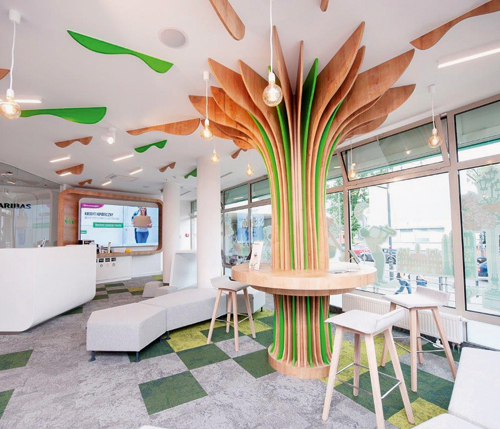
ARS Retail (Miodek Hair House salon in the Klif shopping centre in Warsaw)
Unforgettable – that’s what you are
A brick-and-mortar store has to provide customers with something they cannot experience online. For example, the opportunity to take striking snapshots that can later be published on Instagram. Thus one of the goals for retail interior designers today is to create space that will leave an indelible experience. One example of a brand that employs such a strategy is Lush, a manufacturer of organic cosmetics. “The way its stores are designed and the way its products are exhibited allow the customers to test them out, making every visit unforgettable. The entire effect is complemented by friendly staff and product presentations with the participation of the customers. Dutch brand Rituals has a similar approach,” remarks Grzegorz Rogacki. He emphasises that this physical ‘presence‘ helps build confidence in the brand and contributes to turning customers into promoters on social networks. That’s why the interior design of the stores has to be ‘instagrammable’. “It must encourage people to share the information about their visit. And this is where an original design is crucial, one that involves the creation of a memorable place through its spatial qualities, the materials used or the lighting systems installed. In the future, the physical space of the store will serve as a counterweight to the more intangible digital world that is increasingly permeating in our lives. But we are all striving for the right balance. By the way, rankings for the most ‘instagrammable’ places in the world are already available online,” adds Grzegorz Rogacki. According to him, the ‘wow factor’ of providing an unforgettable experience will, nevertheless, be achieved using traditional methods, offering a service and experience that exceeds visitors’ expectations. In support of this claim, he cites Philip Kotler, who came up with the Marketing 4.0 concept. He describes a situation when a customer of a patisserie asks an assistant if she could make doughnuts in the shape of the Olympic rings. “Unfazed by this unusual order, Jackie Braun of the Krispy Kreme patisserie asks the increasingly stunned customer some questions for clarification, and then – to his amazement – proceeds to fulfil the order. The astonishment is all the greater because this customer, a businessman, was expecting a refusal. It was all part of his plan to help him overcome the rejection phobia he had been suffering from at the time, as he attempted to raise finance for his start-up. But faced with Jackie’s approach to serving customers, all he could do was say: wow! The element of surprise makes the wow effect very personal, and the person who has experienced this then wants to share it – and in this way they are transformed from being an ordinary customer into a brand promoter. In times when media aware customers are becoming ever more immune to marketing ploys, the quality of the shopping experience is now key. So the time has now come for omni-retail – a holistic approach to the development of the sector,” believes Grzegorz Rogacki.
Mateusz Laskowski of Forbis Group is of a similar opinion. “With the development of ne w technological systems, retail space is becoming populated with places designed for a personalised, multi-channel consumer experience that goes far beyond standard shopping. The modern consumer needs strong, regular stimuli during the decision making process. These are provided by fifth generation technological systems that integrate the real and virtual worlds. The combination of online sales tools with traditional visual merchandising generates a positive experience of the brand, with the ‘store of the future’ being a hybrid of the two channels,” insists Mateusz Laskowski.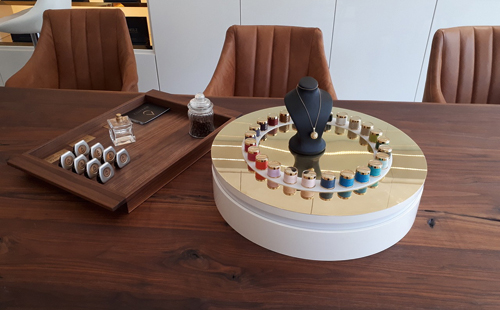
Box Interior (the Birkholz perfumery in Berlin)
Follow the customer
According to Mateusz Laskowski, digital technology will be used not only to enhance the customers’ experience of the brand, but also to study them more closely, so that brands can understand and predict customer behaviour better. “Systems such as beacons integrated with smartphones or intelligent lighting for collating data on how customers move around the store are invaluable for this. Another trend is to reduce the product range in the store, thus preventing the ‘overloading’ of customers’ senses. The consumer is instead given the opportunity to see and touch the products as well as experience the brand, and then, by using multimedia kiosks, order the selected product to the chosen store or directly to their home. Stores of the future, integrated with various sales channels, will abound with these devices, such as multimedia screens, interactive foil, tablets and eye-catching screen walls connected to a remote-controlled network,” predicts Mateusz Laskowski.
The technological revolution, therefore, is having the result of making the actual architecture and design of retail space take a back seat. In such an environment, minimalism would seem to be the perfect approach. “Simple interiors are often more functional and contribute to better product presentation. Interiors with a subtle aesthetic are associated with chic and elegance, while moving around in them is simpler and easier. Along with minimalism, another recent trend is the return to nature and eco-design. By adopting a ‘zero waste’ approach, we try to provide our customers with systems that involve the usage of reusable materials and technology that supports organisations in pursuing their sustainable development goals. This is also reflected in the designs – our clients are happy to choose wooden elements and colours that give a place a more natural feel,” adds Mateusz Laskowski.
Making them stay longer
“In general, interiors are more toned down today, and the furniture is simple so that the products can be displayed better. The materials used for interior design tend to be more natural, often raw or of a very high quality. On the one hand, minimalism, which is derived from the Scandinavian style, is the dominant style. On the other, eclecticism and mixing styles is also popular, but also by using and combining materials intended to encourage people to linger, such as natural materials or perfect imitations of them,” points out Krzysztof Kozak, the managing director of Box Interior. In his opinion, the trend for installing new tech in retail outlets is not called for in all situations. “There are still a large number of customers who have not adapted to life in the digital world and who want to stick with traditional stores. Technology is not a priority for such people, as it also isn’t for brands marketed at a very wide range of customers. If stores become too digitised, this would deter them, rather than draw them in,” argues Krzysztof Kozak. Nonetheless, he also admits that the general purchasing philosophy has changed and shopping has increasingly become a way to spend free time. He gives as an example the relaxation zones increasingly appearing in bookstores, where you can sit with a book and have some coffee. “Another reflection of this trend can be found in the Kontigo drugstore chain we work for. Special zones have been created in the stores where you can test cosmetics on site. In Irena Eris stores now, along with being able to buy their cosmetics, you can also have a spa treatment, And car showrooms are introducing areas for families with children, where you can spend some time familiarising yourself with multimedia advertising gadgets,” comments Krzysztof Kozak.
Kamila Dzionek, the business development hospitality and retail manager at Tétris, is of a similar opinion. She believes that the latest technological systems will not replace our need for physical social space as a source of real life experiences. That’s why the introduction of multisensory systems is another important trend on the retail market. “Brands are increasingly looking for ways to stimulate all the five senses of consumers. Furthermore, there is one other important trend when it comes to the changes in the sector – centres that draw their inspiration from hotel design and that are introducing the ‘well-being’ philosophy. They focus more on the culinary experiences of their guests and on providing the perfect place to spend time with friends,” says Kamila Dzionek.
All the designers we spoke to agree that changes in the approach to shopping have made retail space design an increasingly specialised field today. “It requires constantly acquiring greater knowledge from many fields, including psychology, marketing and business – and this means that studios now need interdisciplinary teams. The interior design itself has become just one element of the whole process,” concludes Krzysztof Kozak.

























